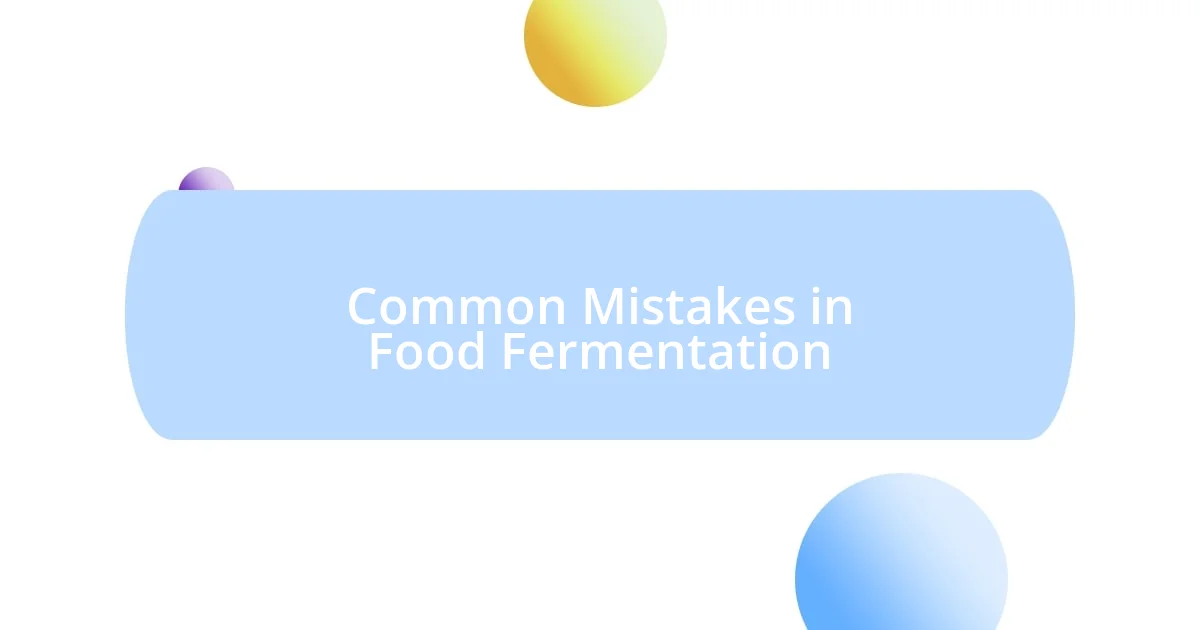Key takeaways:
- Food fermentation transforms simple ingredients into complex flavors and offers various health benefits, such as improved digestion and boosted immunity.
- Essential ingredients for successful fermentation include salt, water, sugar, starter cultures, and flavorings, with attention to seasonal produce enhancing the process.
- Common pitfalls include skipping sterilization, ignoring environmental conditions, and overstuffing jars; patience and knowledge are key to troubleshooting fermentation issues.

Understanding Food Fermentation Basics
Food fermentation is a fascinating process that transforms simple ingredients into complex flavors and textures through the action of microorganisms like bacteria, yeast, and molds. I remember the first time I fermented vegetables; I was amazed at how a handful of cabbage could morph into tangy sauerkraut. It’s like magic, isn’t it? How does something so basic turn into a culinary treasure?
At its core, fermentation relies on the right conditions: temperature, time, and the presence of these tiny organisms. When I started, I struggled with finding the right balance in my kitchen. I wondered, why does my kimchi sometimes taste different? It turns out that even slight variations in temperature can affect the fermentation process. That’s the beauty of it—there’s always something new to learn.
Understanding the basics of food fermentation opens the door to endless creativity in cooking. Each type of fermentation offers its own unique health benefits, and I can’t help but feel a sense of pride every time I share my homemade kefir with friends. Have you ever tried explaining the health advantages of fermented foods? It’s satisfying to see their eyebrows raise in surprise once they realize how much flavor and health they can pack into their meals.

Health Benefits of Fermented Foods
Fermented foods are a treasure trove of health benefits, and I’ve truly felt the difference in my everyday life. One standout benefit is improved digestion. Once I started incorporating yogurt and fermented vegetables into my diet, I noticed a significant reduction in bloating and discomfort. Probiotics, the friendly bacteria found in these foods, support gut health by maintaining a balanced microbiome, which is essential for overall well-being.
Another fascinating aspect is the potential boost to our immune system. I recall feeling a bit under the weather last winter before a big event. I immediately turned to my homemade sauerkraut, packed with vitamin C and probiotics. It helped me bounce back quickly, reminding me how interconnected our gut health is with immune function. This personal experience only reinforces my belief that food can indeed be our best medicine.
Fermented foods are also known to enhance nutrient absorption. When I started making kombucha, I was amazed to learn how it helps unlock nutrients in other food options I consume. For instance, consuming it alongside a meal can improve the bioavailability of iron and minerals. It’s like having a personal chef in my gut, ensuring that I’m getting the most out of my meals.
| Health Benefit | Description |
|---|---|
| Improved Digestion | Fermented foods contain probiotics that promote gut health and reduce bloating. |
| Boosted Immunity | Probiotics in foods like sauerkraut may enhance immune function, helping to fend off illness. |
| Enhanced Nutrient Absorption | Fermented foods can improve the bioavailability of essential nutrients in other meals you eat. |

Essential Ingredients for Fermentation
When I first plunged into the world of fermentation, I quickly realized that a few essential ingredients make or break the process. One of my go-to ingredients is salt, which not only adds flavor but also creates a hostile environment for harmful bacteria while nurturing the good ones. I remember my initial fear of adding too much salt to my cucumber pickles, but it turned out to be the key to that delightful crunch and tang. The balance of salt is truly vital in achieving the perfect ferments.
Here are the essential ingredients I always keep on hand for successful fermentation:
- Salt: Acts as a preservative, controlling the growth of bacteria.
- Water: Use filtered or non-chlorinated water to avoid chemicals that can interfere with fermentation.
- Sugar: Provides food for the yeast, promoting fermentation in items like kombucha or kefir.
- Starter Cultures: These can be live cultures from yogurt or specific fermentation starters that introduce beneficial microorganisms.
- Flavorings: Herbs, spices, or even fruits can enhance the flavor and complexity of your ferments.
I’ve also come to appreciate the importance of seasonal produce. There’s something so special about fermenting fresh summer vegetables; their natural sweetness enhances the final product. One time, I had a bumper crop of tomatoes, and I decided to ferment them with garlic and herbs. The end result turned out so vibrant and delicious that I felt a genuine connection to my small garden and the effort that went into growing those ingredients. It’s these little moments of joy that keep me experimenting and learning.

Key Fermentation Techniques Explained
When it comes to fermentation, there are a few techniques that stand out in my experience. One approach I’ve embraced is the method of brining, which involves submerging vegetables in a salty solution. I remember the first time I made pickles this way; I was nervous about taking the plunge into the unknown. But watching those cucumbers transform over time—from crunchy and bland to tangy and vibrant—was nothing short of magical. It’s this patience during the fermentation process that really pays off.
Another technique worth exploring is the use of anaerobic fermentation, where food is sealed off from oxygen. This method not only promotes the right types of bacteria but also helps retain the food’s natural flavors. I recall my first attempt at making kimchi, where I followed a recipe diligently and made sure everything was tightly packed in the jar. The result was a bold flavor explosion that was utterly satisfying. Isn’t it fascinating how much flavor comes from simply creating the right environment for beneficial bacteria to thrive?
Then there’s the concept of temperature control, which I’ve found pivotal in the fermentation journey. I once misjudged the ambient temperature while fermenting a batch of sourdough starter. Instead of the mild tang I expected, I ended up with something quite sour, but surprisingly, it was delightful in its own right! This experience taught me that sometimes, giving yourself permission to experiment can lead to unexpected and wonderful outcomes. How often do we allow ourselves to embrace the unpredictability in the kitchen?

Common Mistakes in Food Fermentation
When it comes to food fermentation, one of the most common mistakes I’ve made is skipping the sterilization of jars and tools. I vividly remember my first attempt at fermenting sauerkraut. I was eager and a bit impatient, so I just grabbed my old mason jars without a second thought. Unfortunately, that batch ended up spoiled because harmful bacteria took over the unclean surfaces. It taught me the hard way that cleanliness isn’t just a best practice—it’s a cornerstone of successful fermentation.
Another pitfall I’ve encountered involves not paying attention to the fermentation environment. I recall trying to ferment some spicy carrots on my kitchen counter, but I didn’t account for the heat of the summer sun streaming through the window. A few days in, I peeked inside to find a bubbly mess and an overwhelming smell that made my stomach turn. It’s crucial to keep ferments in a place that’s dark and cool to promote the right microbial activity and avoid the chaos of unwanted bacteria.
Lastly, overstuffing my jars has also been a recurring mistake. I remember my excitement when preparing kimchi; I thought, “More is better!” But when fermentation began, I watched in horror as the contents overflowed and created a mess. It was a reminder to leave some headspace for gases to escape and for the ingredients to expand. Have you ever felt overwhelmed just trying to fit everything into place? Sometimes, a little restraint can go a long way in achieving that perfect ferment.

Troubleshooting Fermentation Issues
When troubleshooting fermentation issues, one of the first things I troubleshoot is the smell. I remember opening a jar of miso I had fermented and getting hit with an off-putting odor. My heart sank—was it ruined? I quickly learned that not all unusual smells are bad; sometimes, they’re just part of the fermentation journey. Trusting my instincts can help me differentiate between a natural funk and something genuinely spoiled.
Another key factor to consider is the appearance of your ferment. There was a time when I noticed a strange film forming on top of my kombucha. I panicked, thinking it was mold. With a quick research dive, I found out that sometimes a “scooby” can form during fermentation, and it’s a good sign rather than a bad one. At that moment, I realized how empowering it is to educate myself about these quirks—knowledge truly saves the day. Have you ever found yourself second-guessing what you see in your ferments?
Lastly, I emphasize the importance of patience and time when fermentation doesn’t go as planned. I recall making my first batch of fermented garlic, only to have it stay rock-hard despite weeks of waiting. Frustrated, I almost discarded it, but then I remembered how fermentation is a delicate dance of time and conditions. After another week, not only was it softer, but the flavor had matured beautifully! It made me appreciate the time needed for fermentation. Have you ever found that waiting can lead to unexpected surprises? Sometimes, those moments teach us the most.

Delicious Recipes Using Fermented Foods
One of my absolute favorite ways to incorporate fermented foods into meals is by making a zesty kimchi fried rice. A few weeks back, I had some leftover kimchi from a batch I had fermented. I tossed it into a hot skillet with some day-old rice, a splash of soy sauce, and a sprinkle of green onions. The explosion of flavors was so delightful that I couldn’t help but dance a little in the kitchen! Have you ever experienced that moment when something just comes together perfectly?
I also enjoy using fermented garlic in pasta dishes. Recently, I prepared a simple aglio e olio, where I swapped out fresh garlic for my fermented version. The result? A subtle, tangy richness that elevated the dish. It was such a hit with my friends that I got bombarded with questions about how I made it! This taught me that a little creativity with fermented ingredients can truly make a meal shine. Isn’t it amazing how one simple change can create such a memorable experience?
Another recipe I love is a refreshing cucumber salad dressed with a splash of homemade sauerkraut brine. I’d stumbled upon this idea while pondering what to do with my abundant cucumber harvest. Tossing cucumber slices with dill and a generous amount of the brine not only adds flavor but also packs a nutritious punch. Each bite bursts with crispness and tang, and I found myself savoring every morsel. Have you ever thought about using leftovers in completely new ways? You might be surprised at how rewarding it can be!














